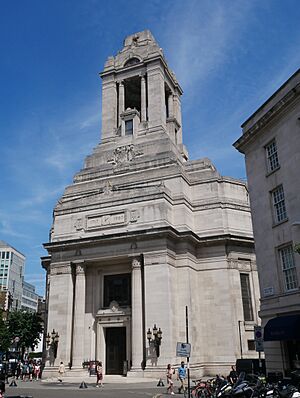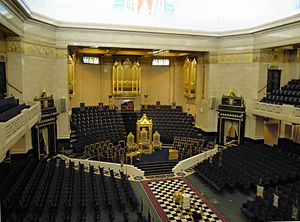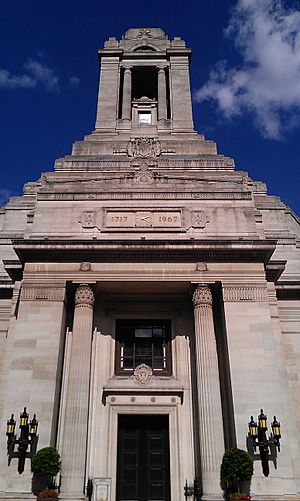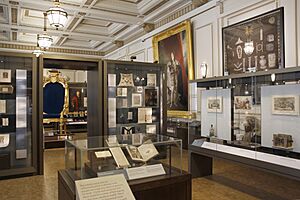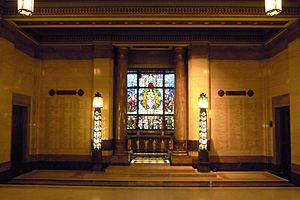Freemasons' Hall, London facts for kids
Freemasons' Hall in London is a very important building. It's the main office for the United Grand Lodge of England, which is a big group of Freemasons. It's also where many local Freemason groups meet.
You can find this building on Great Queen Street, between Holborn and Covent Garden. People have been meeting here since 1775!
Some parts of the building are open to everyone every day. It has a cool, old-fashioned style called Art Deco. Because it looks so unique, it's often used for movies and TV shows. This makes it a popular place for tourists to visit.
Contents
A Look Back: The First Buildings
The land where Freemasons' Hall stands has a long history. In 1775, the first group of Freemasons bought a house here. They built a large meeting hall behind it. This first hall was officially opened on May 23, 1776.
Over the years, the building changed. An addition was made in 1820, but it was later taken down.
The first building was updated and made bigger in 1862. However, a fire in 1883 made it weak. Parts of this second building were removed in 1910.
The Current Building: A Memorial
The building you see today is the third one on this spot. It was built between 1927 and 1933. It was designed in the Art Deco style by architects Henry Victor Ashley and F. Winton Newman.
This grand building was created to remember the 3,225 Freemasons who bravely died fighting in World War I. It covers a large area, about 2 and a quarter acres.
At first, it was called the Masonic Peace Memorial. But when World War II started in 1939, its name was changed to Freemasons' Hall. Money for the building came from the Masonic Million Memorial Fund, which raised over £1 million. Today, it's a Grade II* listed building, meaning it's a very important historical site.
In 1967, a clock was added above the main entrance. It has the dates "1717" and "1967" next to it. This marked 250 years since the main Freemason group was formed in 1717.
The Grand Temple: A Special Meeting Place
The most important room in the building is the Grand Temple. This is where the biggest Freemason groups hold their meetings. Many local London groups also meet here.
The Grand Temple is not just for Freemasons. It's also used for many other events. You might see Fashion shows or university award ceremonies held here!
The huge bronze doors leading into the temple are very heavy. Each one weighs over a tonne! Inside, the room is 123 feet long, 90 feet wide, and 62 feet high. It can seat 1,700 people.
The ceiling has beautiful Mosaic artwork. It shows symbols from Freemasonry and figures representing good qualities like Prudence (being careful), Temperance (being moderate), Fortitude (being brave), and Justice (being fair).
A very large pipe organ was put in the temple in 1933. It was later fixed up in 2015. Now, it sounds even more amazing!
Other Unique Temples
Besides the Grand Temple, there are 26 other special meeting rooms, called temples, in the building. Each one is decorated in its own unique Art Deco style. No two are exactly alike!
For example, Temple No 10 has a mix of classic Art Deco and Egyptian designs. It also has a tall, domed ceiling. Temple No 11 was funded by donations from Japan, so it's decorated with beautiful Chrysanthemum flowers, which are important in Japan. Temple No 12 is known as the Burma Temple and features artwork from Burma.
Temple No 17 has a large carved swan on one wall, which is a symbol for Buckinghamshire. This temple is used by some of the oldest Freemason groups in London.
In 2018, three new smaller temples (Temples 25, 26, and 27) were created. These are for very small meetings.
There are also simpler temples used for practice meetings. While you can tour the Grand Temple, most of these other temples are usually busy with private meetings and are not open to the public.
The Museum of Freemasonry
The Museum of Freemasonry is located inside Freemasons' Hall. It's a museum, library, and archive all about Freemasonry and other similar groups. It's a charity and is recognized for its important collection.
The museum is open to everyone, and it's free to enter! You can see Masonic artworks, special objects, and uniforms. There are also everyday items with Masonic decorations, like clocks, furniture, and jewelry.
The library is also open to the public. It has many books and old papers about Freemasonry from England and around the world. It also has information on other interesting traditions. You can even look up their collection online.
The museum also offers workshops, events, and special exhibitions throughout the year. All exhibitions are free to visit.
Other Things You'll Find
Beyond the temples and museum, the building has many other areas. There are offices for managing the Freemason groups and storage spaces for their belongings. You'll also find a Masonic shop, meeting rooms, and a café-bar.
A whole floor is dedicated to charity work, where all the Freemason charities have their offices. The Metropolitan Grand Lodge of London, which has about 40,000 members, also runs its operations from this building.
See also
- Freemasonry
- Mark Masons' Hall, London
- List of Masonic libraries


